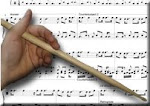I was recently viewing a discussion of polyrhthms on a popular Prog forum. One thing I noticed was a lack of consideration that there is more than one concept that goes by that name. One concept of polyrhythm consists of the sounding of two seperate time signitures simultaneously, i.e 5/4 and 4/4. In this example, after five measures of 4/4 and four measures of 5/4 both meters will land together on "one". Many examples of this in Prog music were cited, including songs by King Crimson, Tool, and Meshugga. I love this stuff and it can get really crazy. The measures don't have to be based on the quarter note either. You could just as easily play 13/16 against 7/8, the principle is the same.
The other polyrhythm concept that was not really discussed is the idea of the "tuplet", i.e. triplet, quintuplet, sextuplet, septuplet, etc. This is the case where an odd number of notes is evenly distributed across an evenly divided number of beats, or vice versa. An example is a measure of 2/4 time comprising an even division of two quarter per measure. If I evenly distribute three quarter notes across the measure I have a triplet, or a 3:2 polyrhythm. The trick is to play the triplet and the duplet simultaneously. This is not so dificult with simple polyrhythms like 3:2, 5:2, 5:3, etc, especially if the occurance of the polyrhythm is isolated. You just find that the larger number is played slightly faster than the smaller number. This becomes much more dificult when you have multiple tuplets of varying degrees ocurring in rapid succession. This is the case with Frank Zappa's The Black Page, (a prog masterpiece).
The Black Page is actually in 4/4 time, however each measure is incredibly syncopated, and the piece is full of polyrhythms that are constantly changing and ocurring in rapid succession. For instance, in measure two there are 16th note triplets on the first half of beats one and two, followed by an eighth note quintuplet across beats 3 and 4. At measure four, beat one is 32nd notes, beat two is a 16th note triplet and 32nd note quintuplet, and beats three and four are both septuplet figures. Beats three and four of measure five are subdivided into a quarter note triplet, however beat one of the triplet is further subdivided into a quintuplet, beat two is a quintuplet, and beat three is a sextuplet. This figure occurs four times in the score. Here is a link to a video of Terry Bozzio playing The Black Page:
The Black Page
The video Terry Bozzio And Chad Wackerman: Solos And Duets features the two drummers performing The Black Page drum solo simultaneaously. They run the score measure by measure underneath the performance, so with some manuscript paper and the pause button on my handy remote, I was able to write out the whole score.
Here is a link to a brilliant article by Steve Vai on the subject of ployrhythms:
Tempo Mental
Further reading
wiki on polyrhythm
Wednesday, November 28, 2007
Subscribe to:
Post Comments (Atom)


No comments:
Post a Comment